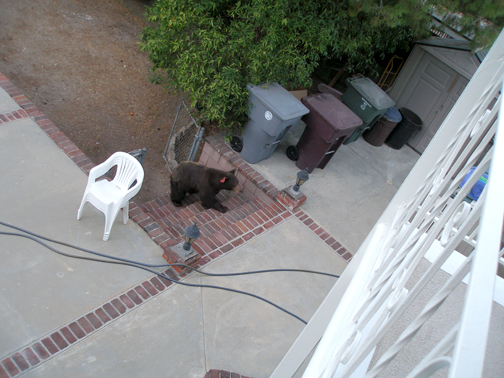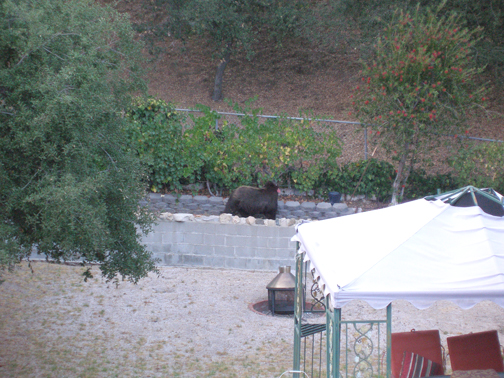
This bear recently spent more than an hour eating grapes and apples in the yard of a Whiting Woods residence. Then he rested under the residence’s oak tree before crashing over their fence to visit neighbors down the hill.
By McKenna MIDDLETON
In response to recent bear sightings in Crescenta Valley, the California Dept. of Fish and Wildlife hosted a bear aware meeting on Monday, Aug. 8. The meeting took place from 7 p.m. to 8 p.m. at Sadler Hall at St. Luke’s of the Mountains Episcopal Church. California Dept. of Fish and Wildlife Public Information Officer Andrew Hughan and Game Warden Marty Wall answered questions from concerned community members, dispelled common myths about bears, and presented helpful ways to keep bears out of neighborhoods.
“There are certainly bears right up the hill. But, as I like to say, this is not a bear problem – it’s a people problem,” Hughan said.
Experts estimate that about 30,000 black bears call California home; however, there is no way to know the exact number.
“There are no signs to support that there are more bears,” Hughan said. “However, everyone has an HD camera in their pocket. So all it takes is one tweet to the media and it’s a bear story. There are no more bears, but there’s much more awareness of bears.”
There has never been a recorded bear fatality in California. Although scary and often bothersome, black bears are not aggressive creatures, though they may do something called a bluff charge.

“Things that bears do very commonly which people interpreted as aggression is a bluff charge,” Wall said. “They’ll take a couple steps toward you and stomp their feet at you; they [make] a sound I call huffing. What the bear is doing [is] he’s giving you a warning and it’s an anxious reaction. They’re getting uncomfortable. You’re either getting too close to that pizza they want to finish or you are blocking their exit.”
As far as dealing with the recent presence of bears in Crescenta Valley communities, such as Whiting Woods, Oakmont Woods, and Briggs Terrace, Hughan and Wall explained that the goal is to give bears a healthy fear of humans. Most often, this constitutes hazing young bears by shooting them with non-lethal beanbag rounds.
Even when bears are relocated, game wardens cannot move bears more than 20 air miles away from where they found them. Bears have a good memory and tend to return to their neighborhood of choice within a few weeks.
“Relocation is not what everyone thinks it is,” Wall said. “When you move an animal, that animal is being put in a strange environment where they don’t know how to find things.”
Because the bears are not aggressive and are usually just looking for an easy meal or a dip in a pool, there is not much law enforcement can do to lower the frequency of bear sightings. However, Wall and Hughan outlined a few simple tips to keep bears out of local neighborhoods.
When the options for a bear’s next meal are limited, a yard looks less appealing. Do not put out water or food for the bears and make sure to keep fruit trees clean by picking fruit as soon as it is ripe. Pouring ammonia in trashcans also helps detract bears from eating out of trashcans. On the more expensive side, motion activated sprinklers and rolling top fences work to keep bears out of yards.
Most importantly, if a bear is seen in a yard, do not approach it to take a picture or video.
“I can boil it down to one rule,” Wall said. “You never want to be in between where a bear is and where he wants to be.”
